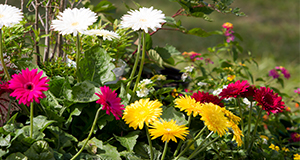Abstract
This article summarizes ornamental plant producers’ current production practices with a specific emphasis on their use of neonicotinoid and non-neonicotinoid insecticides. Written by Hayk Khachatryan, Xuan Wei, and Alicia Rihn, and published by the UF/IFAS Food and Resource Economics Department, July 2021.
References
Allahyari, M.S., C.A. Damalas, and M. Ebadattalab. 2017. Farmers' technical knowledge about integrated pest management (IPM) in olive production. Agriculture 7(12):101. https://doi.org/10.3390/agriculture7120101
Beckmann, V., E. Irawan, and J. Wesseler. 2009. The effect of farm labor organization on IPM adoption: Empirical evidence from Thailand. Institutional Change in Agriculture and Natural Resources Discussion Papers 55767, Humboldt University Berlin, Department of Agricultural Economics.
Douglas, M. R, and J. F. Tooker. 2015. “Large-scale deployment of seed treatments has driven rapid increase in use of neonicotinoid insecticides and preemptive pest management in U.S. field crops.” Environmental Science & Technology 49(8): 5088–5097. https://doi.org/10.1021/es506141g
Fernandez-Cornejo, J., E.D. Beach, and W. Huang. 1994. The adoption of IPM techniques by vegetable growers in Florida, Michigan and Texas. Journal of Agriculture and Applied Economics 26(01): 158-172. https://doi.org/10.1017/S1074070800019271
Furlan, L., and D. Kreutzweiser. 2015. Alternatives to neonicotinoid insecticides for pest control: Case studies in agriculture and forestry. Environmental Science and Pollution Research 22:135-147. https://doi.org/10.1007/s11356-014-3628-7
Hodges, A.W., H. Khachatryan, C.R. Hall, and M.A. Palma. 2019. Executive Summary of Economic Contributions of the Green Industries in the United States in 2018. AmericanHort.
Hovhannisyan, V., and H. Khachatryan. 2016. Ornamental plants in the United States: An economic analysis of household-level demand system. Agribusiness: An International Journal 33 (2): 226-241. https://doi.org/10.1002/agr.21488
International Association of Horticultural Producers (AIPH). 2019. Ornamental horticulture - A growing industry. The International Vision Project, IVP Report. Available at www.aiph.org. (accessed 22 January 2019)
Jeschke, P. and R. Nauen. 2008. Neonicotinoids- from zero to hero in insecticide chemistry. Pest Management Science 64:1084-1098. https://doi.org/10.1002/ps.1631
Jeschke, P., R. Nauen, M. Schindler, and A. Elbert. 2011. Overview of the status and global strategy for neonicotinoids. Journal of Agricultural and Food Chemistry 59:2897-2908. https://doi.org/10.1021/jf101303g
Jones, V.P., T.R. Unruh, D.R. Horton, N.J. Mills, J.F. Brunner, E.H. Beers, and P.W. Shearer. 2009. Tree fruit IPM programs in the Western United States: The challenge of enhancing biological control through intensive management. Pest Management Science 65(12):1305-1310. https://doi.org/10.1002/ps.1839
Madigan, J. 2018. Plant & flower growing in the US. IBISWorld Industry Report 11142.
Nebraska Extension at University of Nebraska-Lincoln. 2016. Neonicotinoid Insecticides - Pollinators, Plants and Your Garden. (accessed 16 January 2020) <https://extension.unl.edu/statewide/cass/Neon- ictinoid%20Insecticides%20-%20Pollinators %2C%20Plants%20and%20Your%20Garden %20...%20August%2012%2C%202018.pdf>.
Osman, K. A., A. I. Al-Humaid, , S. M. Al-Rehiayani, and K. N. Al-Redhaiman, (2011). Estimated daily intake of pesticide residues exposure by vegetables grown in greenhouses in Al-Qassim region, Saudi Arabia. Food Control 22(6), 947e953. https://doi.org/10.1016/j.foodcont.2010.11.031
Schimmenti, E., A. Galati, V. Borsellino, C. Ievoli, C. Lupi, and S. Tinervia. 2013. “Behaviour of Consumers of Conventional and Organic Flowers and Ornamental Plants in Italy.” HortScience 40(4): 162–171. https://doi.org/10.17221/115/2013-HORTSCI
USDA NASS. 2011. 2009 Nursery and floriculture chemical use. United States Department of Agriculture, National Agricultural Statistics Service (USDA/NASS), Washington, DC.
USDA NASS. 2019. Floriculture crops 2018 summary. United States Department of Agriculture, National Agricultural Statistics Service (USDA/ NASS), Washington, DC.

